
Sustainable Transportation for a World Beyond Oil
Ron Swenson, President, EcoSystems
Contact
ABSTRACT
The world is about to experience a real "energy crisis," likely to be a calamity unparalleled in human history. As global environmental crises mount, increasing the demand for energy resources, we will be confronted with a rapid decrease in availability of oil, the cheap resource which has fueled the rise of the modern economy and the information age. We will be forced, in a very short time, to abandon the oil economy.
Like communities all around the world, Santa Cruz has urgent needs for better transportation, and the choices are to begin again using the existing rail line or to expand the roadways. Towards our goal of creating "NOPEC" -- Non-Oil Power Exporting Communities, EcoSystems is developing a Solar Electric UltraLite Rail Public Transit System for the existing rail corridors in Santa Cruz, California, to help create a viable world beyond oil.
We will first develop the background which compels us to create sustainability, namely, the dwindling of our global oil reserves. Next we will consider strategies for achieving sustainability in transportation, and then delve into the details of our proposed solution for Santa Cruz.
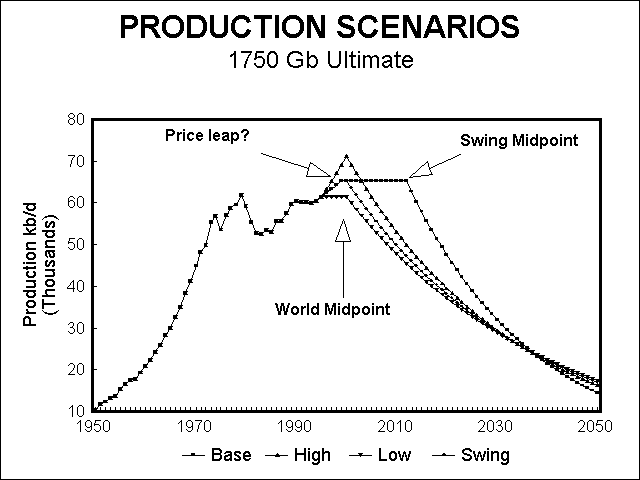
BACKGROUND
World Oil -- Reserves, Production, Politics and Prices -- Possible Scenarios of Future Oil Availability
In 1956, over the vehement objections of his employers, Dr. M. King Hubbert predicted that USA petroleum output would peak around 1970. He was right, and it was then that we experienced the first "energy crisis." In 1974, Dr. Hubbert predicted that world petroleum output would peak around 1995. Based on refinements in available data (oil resources in virtually the entire world have now been charted), a recent study prepared by Dr. Colin J. Campbell on behalf of PetroConsultants concluded that world petroleum output will peak around 1999, and will decline rapidly thereafter. This graph, the well known "Hubbert Curve," as revised by Dr. Campbell, depicts this inevitable peak and subsequent decline in reserves of cheap, pumpable oil in the coming years. Dr. Campbell described his findings in a recent series of articles in SunWorld. [Campbell, 1994]
STRATEGIES FOR SUSTAINABLE TRANSPORTATION
We will next examine strategies whereby sustainability can be achieved. There are two major elements in this strategy: (1) finding renewable sources of energy suitable to the requirement of mobility, and (2) achieving greater efficiency.
Renewable Sources
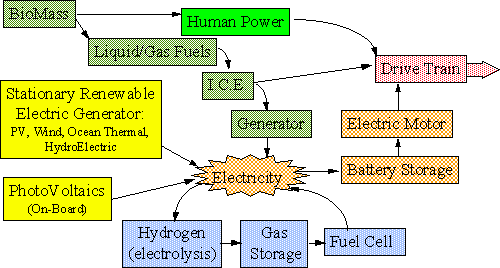 The various paths to sustainability are depicted in this illustration:
The various paths to sustainability are depicted in this illustration:
Liquid Fuels
.
Many attempts at renewable sources of energy for transportation have focussed on fuels. Liquid fuels are certainly appropriate for airplanes, and probably for long distance trucks and buses for the foreseeable future. However, in congested urban areas, liquid fuels are becoming inappropriate, and not only due to the obvious result of air pollution, but also in consideration of energy efficiency, noise reduction, and the potential for use of diversified energy sources.
"Cars that run on ethanol, methanol and compressed natural gas produce less emissions than conventional automobiles, but savings are only in the 20-50% range, and do not appreciably reduce carbon dioxide the greenhouse gas. (Source: Environmental Action, July 1989) Electric rail can reduce emissions by 50-90%. (Source: Mass Transit: Clean Air Alternative, a report by the American Public Transit Assn.)" [NESEA, 1995]
Other Diverse Renewable Sources
For urban living, humanity has largely given up the idea of using wood stoves in the kitchen. It is just as preposterous to imagine a viable future urban transportation system using liquid fuels. The universal "fuel" is electricity -- to make use of diversified fuel sources implies an electric drive train. Here is the rationale in clear terms:
- Burning 1 gallon of gasoline yields 22 lbs. of carbon dioxide, the major greenhouse gas.
- Air pollution has been named the #1 health threat to Americans by the American Lung Assn.
- Transportation causes up to 60-90% of urban air pollution, and 55% of the air pollution in the Northeast.
- Transportation produces .... 30% of U.S. carbon dioxide .... 76% of carbon monoxide .... >41% of nitrous oxide (NOx) ...38% of hydrocarbons ...5% sulfur oxide (SOx)....23% particulate emissions ....25% of CFC emissions....
- Electric vehicles (EVs) have zero emissions at the tail pipe.
- If electricity for EVs is produced in today's power plants in the NE, emissions are reduced by 27%
- If electricity for EVs is produced by wind, and solar technologies, EVs are pollution-free.
(Source: Steering a New Course, by Deborah Gordon, Union of Concerned Scientists, 1991)" [NESEA, 1995]
Developing Markets will Emerge First
Developing countries can take a key role in the development of EV's, by establishing a whole new class of vehicles for domestic sale and export, designed appropriately for our dwindling global oil supplies and designed to be successful in developing markets where ordinary new cars are very expensive (as is true in much of Latin America), or do not yet exist in quantity (China/India). These vehicles would be very utilitarian and inexpensive. Also these countries may effectively develop components for export to other markets. An example:
TAIPEI, Dec 27 (Reuter) - Taiwan's largest industrial conglomerate, Formosa Plastics group, is considering making electric cars in Taiwan and China, a company official on Wednesday quoted chairman Wang Yung-ching as saying. "Chairman Wang says the company is currently evaluating the electric car project but no final decision has been made," the official said. [Reuters, 1995a]
Efficiency
In spite of the resistance to electric vehicles, there is a strong push within the automotive industry for what is being called the "SuperCar" by Amory Lovins. This "hybrid-electric" vehicle would carry an on-board charging engine fueled by gasoline or natural gas (and/or eventually a hydrogen-powered fuel cell). The key point to understand is that the drive train will necessarily be electric.
It is clear that EV's deliver substantially better overall efficiency from a given quantity of fuel. (For example, assuming electrical generating plants are oil-fueled, EV's generally go 2 to 3 times as far for a given amount of fuel. Plus, obviously, they can be operated on the basis of fuels which are not as strategically or politically valuable as oil. Consider the dramtic evidence from the most complete and accurate facts prepared by N.E.S.E.A., sponsors of the annual American Tour de Sol, regarding the energy efficiency performance of electric and hybrid vehicles. [Groh, 1995]
To achieve efficiency, engineering must address aerodynamics, weight, the drive train, and rolling friction:
The Ultralight Strategy. "The incremental approach to improvements saves so little fuel because it focuses disproportionately on fine points of engine and transmission design while comparatively neglecting the basic strategy of making the car very light and aerodynamically very slippery. This strategy rests on the basic physics of cars: in urban driving on a level road, drivewheel energy--typically only ~15-20% of fuel input energy is devoted about one-third to heating their brakes when they stop, one-third to heating the air they push aside, and one-third to heating the tyres and road (MacCready 1991). On the highway, air resistance, proportional to the square of speed, accounts for ~60-70% of tractive energy needs. The keys to automotive fuel economy, therefore, are braking and downhill-coasting energy recovery, aerodynamic drag, tyre rolling resistance, and mass. Benefits from improving any one of these are limited, but benefits from improving all of them together are striking, and they often reinforce each other." [Lovins & Lovins, 1995]
ULTRALIGHT RAIL FOR SANTA CRUZ
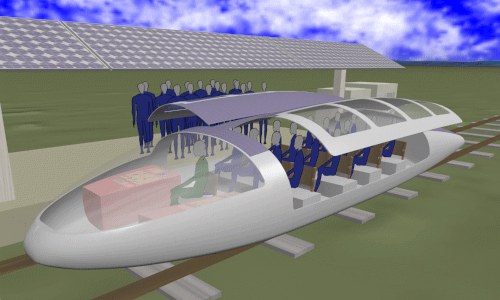
Solar-electric rail is a smokeless, noiseless rail transit system based on recent advances in solar racing car technology. The electric power will involve a utility grid/solar photovoltaic mix, with the mix changing as PV costs come down. Following is a listing of the features and benefits of the UltraLite Rail System.
Benefits
The goals of our Ultralite is to reach 100-200 lbs/passenger, to lower energy consumption. It will be virtually silent, autonomous, with opportunity charging at stations. With electric propulsion, it will have low maintenance. It will be aerodynamic, low profile, unlike a bus or train, but like an oversized sports car. The rail itself is easy to install (feasibly on existing streets for automobiles) and removable if requirements change. Priority will be given to local development and fabrication.
Technical Aspects
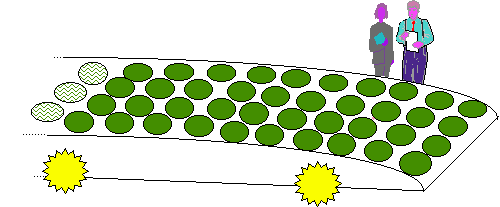 On-Board Solar Panel. An 8'x20' (160 sq ft) panel area can provide 2 kw solar power (3 HP peak). For a very light, aerodynamic vehicle, this is a substantial portion of the power required. It will have light weight, low power electric motors. The novelty of using solar on-board will create appeal for ridership.
On-Board Solar Panel. An 8'x20' (160 sq ft) panel area can provide 2 kw solar power (3 HP peak). For a very light, aerodynamic vehicle, this is a substantial portion of the power required. It will have light weight, low power electric motors. The novelty of using solar on-board will create appeal for ridership.
Seating. We are planning to incorporate low profile seating, with gull wing doors (roof lifts for access). There will likely be open air seating for summer days. It will accommodate 10-20 passengers, seated in rows facing sideways or 4 abreast, with access from both sides.
Structure. The prototype will employ a very simple box structure. It will be made of composite materials (fiberglas, honeycomb, kevlar, carbon fiber). An example of an existing industry initiative substantiates their anticipation of this approach:
"XCORP, Designers of XCAR, The Supercar for the Next Generation" -- The next generation automobile will have to meet far more rigorous demands than current technology can produce. This Supercar must offer more value for less money while producing less emissions and at three times current average fleet MPG. This vehicle will be easily and totally recyclable, adapt more quickly to fast changing market forces and require far less labor content so that it can employ American labor in well paying smart jobs...." [XCORP, 1996]
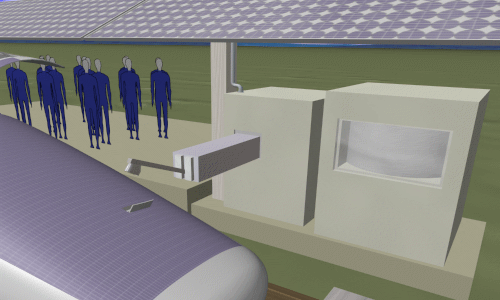 Solar Charging Station. Solar charging will consist of 10 KW of solar panels per station (about 1,000 sq ft of rooftop area that will shelter riders from elements while embarking/disembarking). A flywheel or similar electrical storage at each station will facilitate rapid opportunity charging while in the station.
Solar Charging Station. Solar charging will consist of 10 KW of solar panels per station (about 1,000 sq ft of rooftop area that will shelter riders from elements while embarking/disembarking). A flywheel or similar electrical storage at each station will facilitate rapid opportunity charging while in the station.
Program Development Schedule
A video has been produced, and is being presented in the community. The present schedule is to do preliminary engineering in winter and spring of 1996, and prototype construction in the summer and fall of 1996. Ongoing video documentation will capture the prototyping and testing process. A budget of about $100,000 has been estimated for these activities.
CONCLUSION
UltraLight Rail is one potential key element in creating a transportation system using sustainable energy sources. A group is developing a prototype for the existing rail line in Santa Cruz, California.
BIBLIOGRAPHY
Campbell, Colin (1994). The imminent end of cheap oil-based energy. SunWorld, Vol 18. No. 4
Campbell, Colin (1996). World Oil -- Reserves, Production, Politics and Prices -- Possible Scenarios of Future Oil Availability, 1996, http://ecotopia.com/campbell.htm
Environmental Policy Network (1996). "Environmentalists call Air Board's Secret Electric Vehicle Ageement Illegal 'Drive to Extinction'...", CALSTART News, 2/8/96 http://www.calstart.org/news/pr/96020802.html
Groh, Jack (1995). Electric Cars Proven Twice as Efficient as Gasoline Models. NESEA News Release, June 8, 1995, http://nesea.nrel.gov/mpg.html
Lovins, Amory and L. Hunter Lovins (1995). Reinventing the Wheels -- The Ultralight Strategy, Atlantic Monthly, January, 1995 http://solstice.crest.org/efficiency/rmi/hypercars/Reinventing_the_Wheels.html
NESEA (1995). The Automobile, Energy and the Environment, Fact Sheets http://nesea.nrel.gov/nesea.html
Reuter News Wire (1995a). Taiwan's largest industrial conglomerate, Formosa Plastics group, is considering making electric cars in Taiwan and China..." Reuters, 12/27/1995 http://ecotopia.com/webpress/wre4/china.htm.
Reuter News Wire (1995b). California unveils alternative electric car policy. Reuters, 12/21/1995. http://ecotopia.com/webpress/wre4/ca_regs.htm.
Swenson, Ron (1996). Ultralight Rail for Santa Cruz, http://ecotopia.com/ulr.
XCORP (1996). Designers of XCAR, The Supercar for the Next Generation. http://www.xcorp.com/



 The various paths to sustainability are depicted in this illustration:
The various paths to sustainability are depicted in this illustration:

 On-Board Solar Panel. An 8'x20' (160 sq ft) panel area can provide 2 kw solar power (3 HP peak). For a very light, aerodynamic vehicle, this is a substantial portion of the power required. It will have light weight, low power electric motors. The novelty of using solar on-board will create appeal for ridership.
On-Board Solar Panel. An 8'x20' (160 sq ft) panel area can provide 2 kw solar power (3 HP peak). For a very light, aerodynamic vehicle, this is a substantial portion of the power required. It will have light weight, low power electric motors. The novelty of using solar on-board will create appeal for ridership.
 Solar Charging Station. Solar charging will consist of 10 KW of solar panels per station (about 1,000 sq ft of rooftop area that will shelter riders from elements while embarking/disembarking). A flywheel or similar electrical storage at each station will facilitate rapid opportunity charging while in the station.
Solar Charging Station. Solar charging will consist of 10 KW of solar panels per station (about 1,000 sq ft of rooftop area that will shelter riders from elements while embarking/disembarking). A flywheel or similar electrical storage at each station will facilitate rapid opportunity charging while in the station.